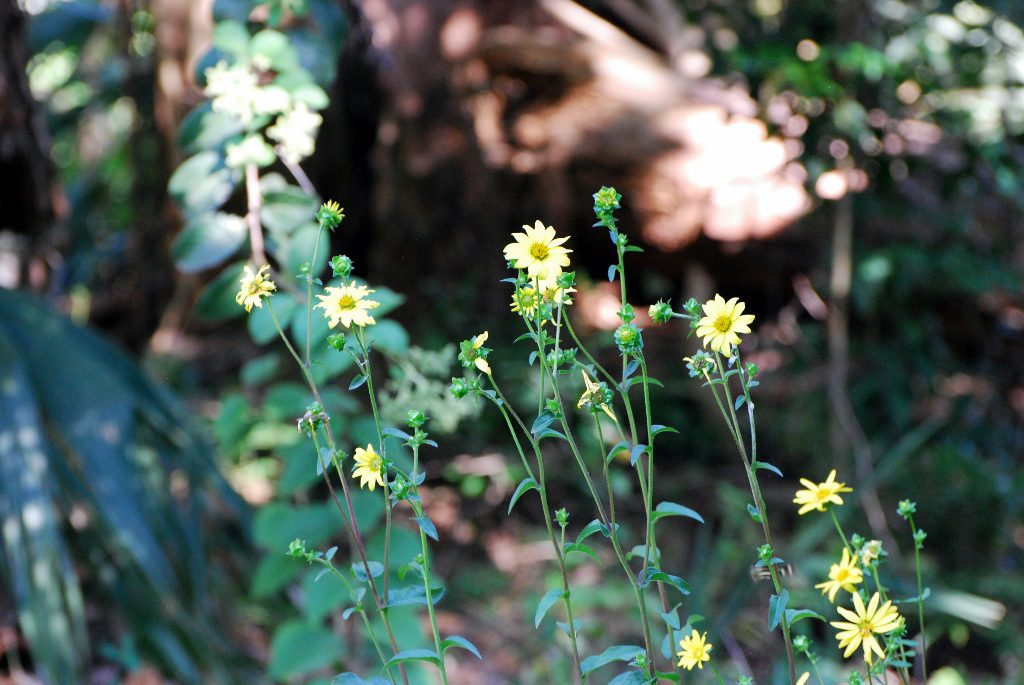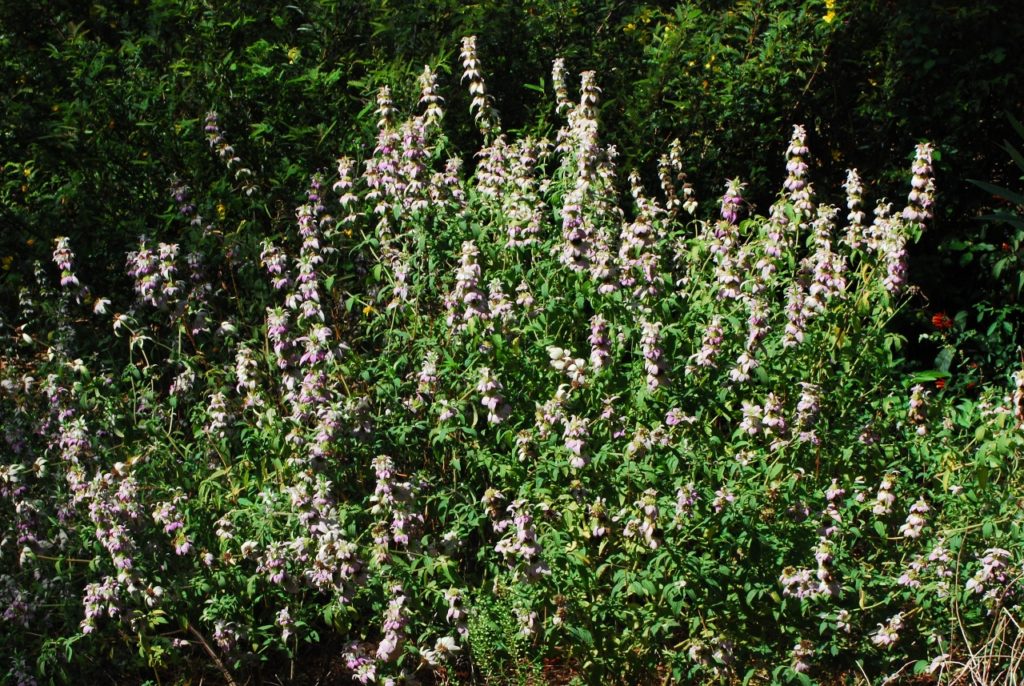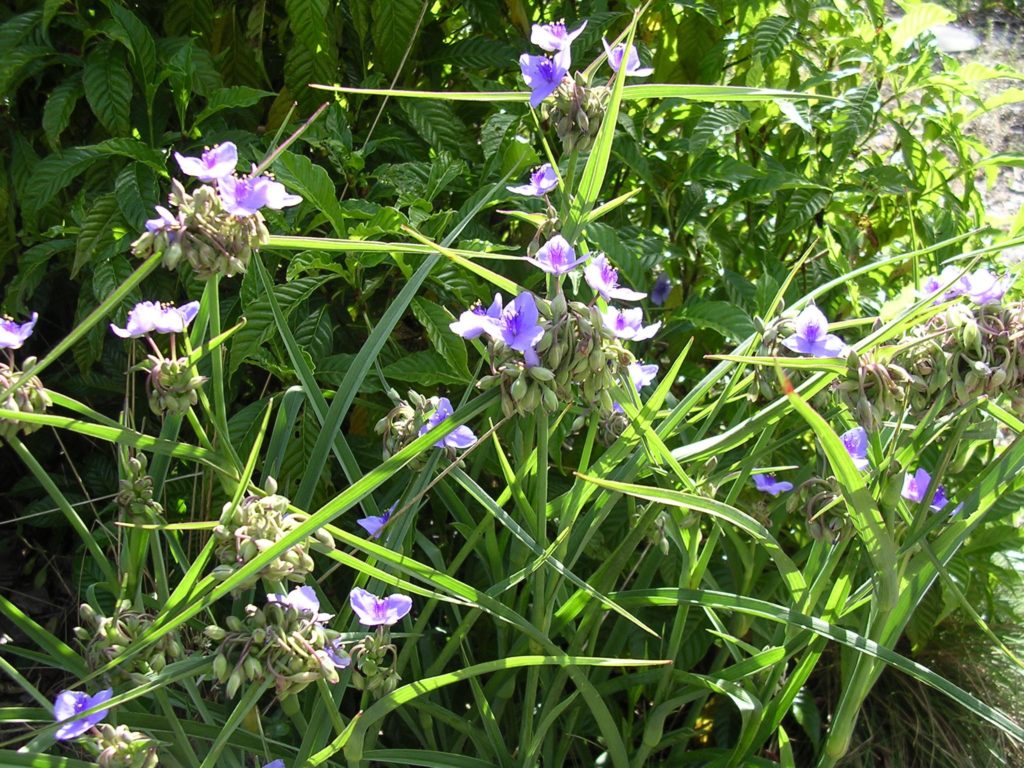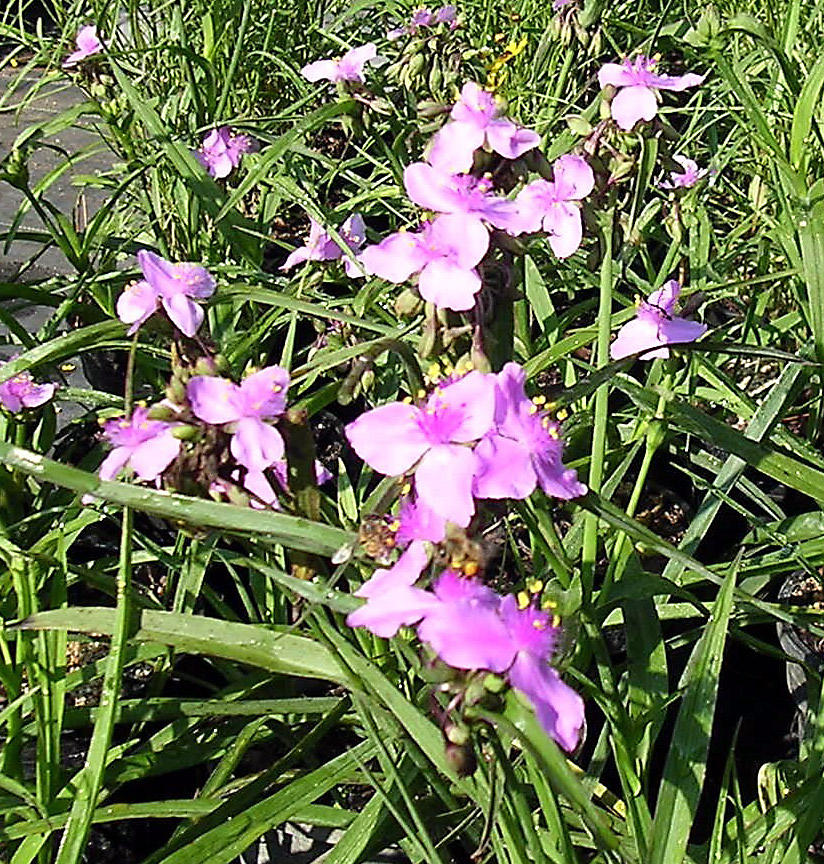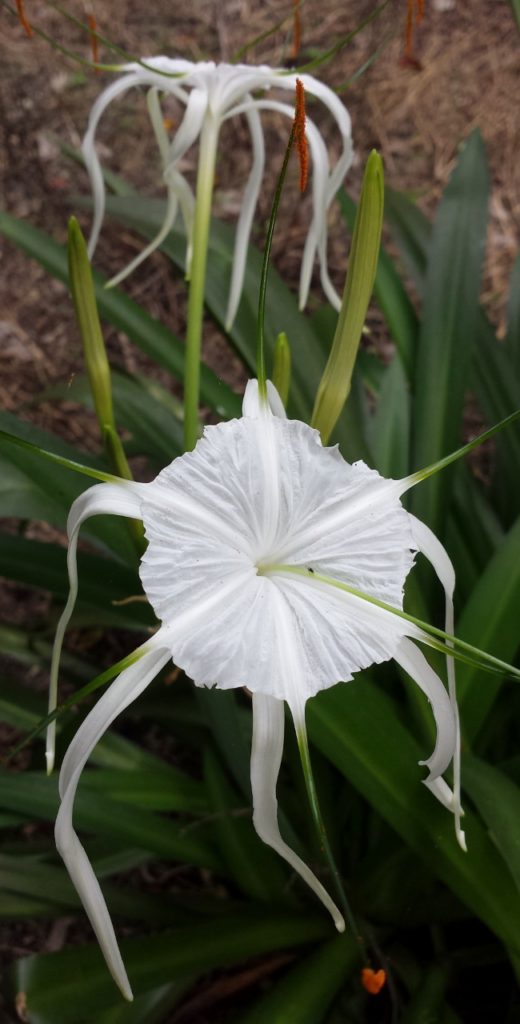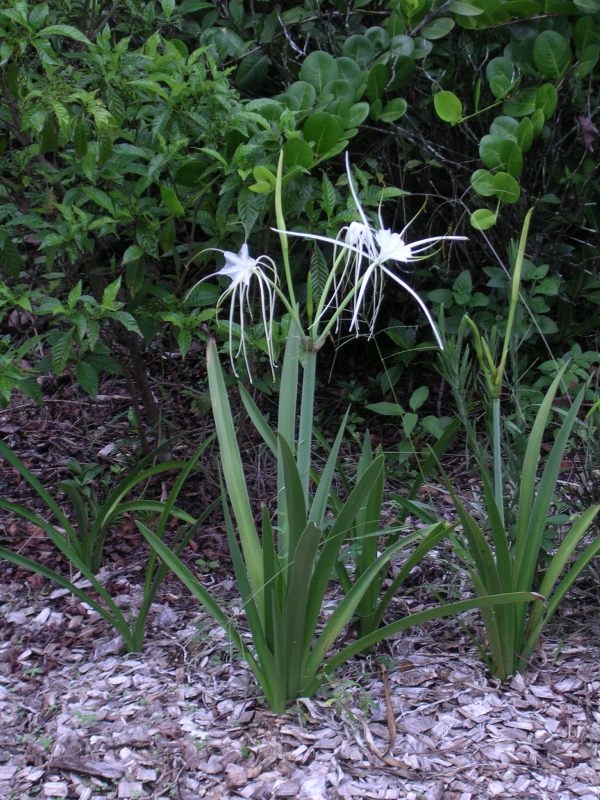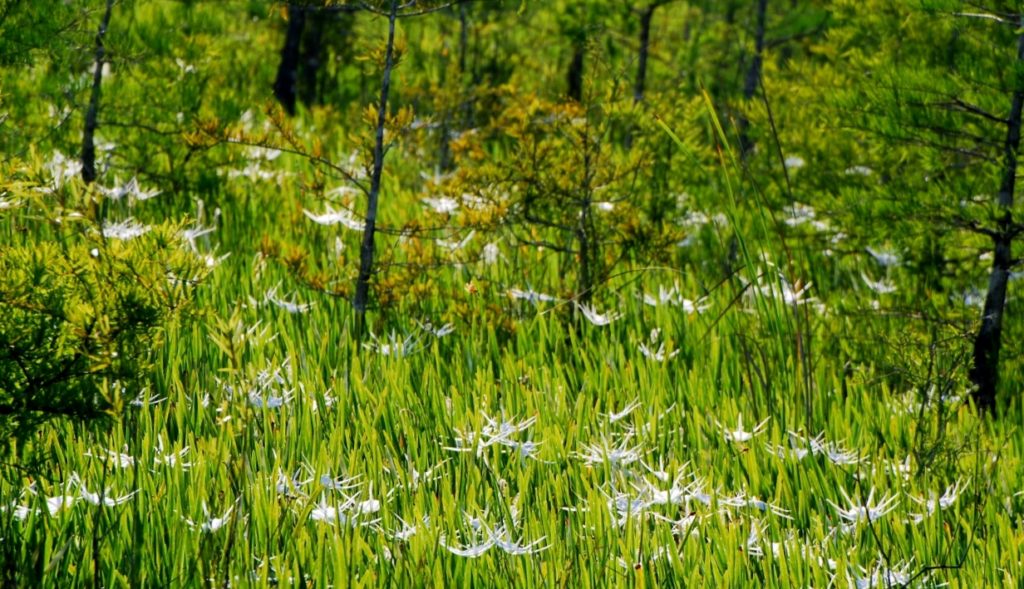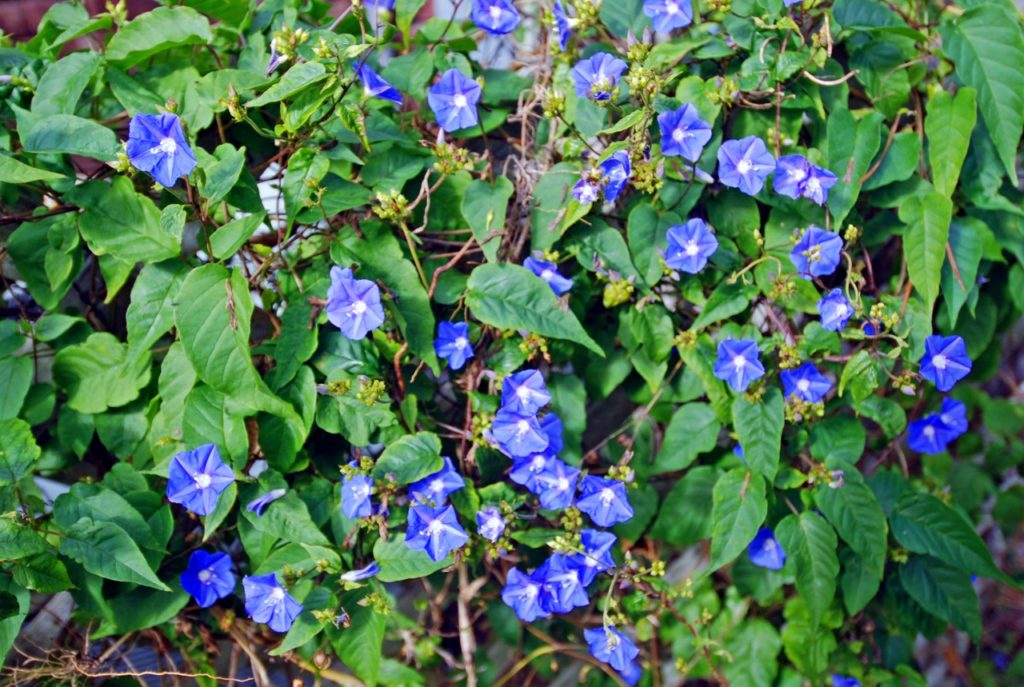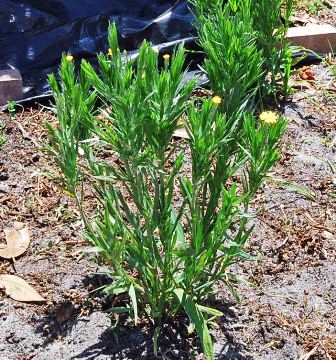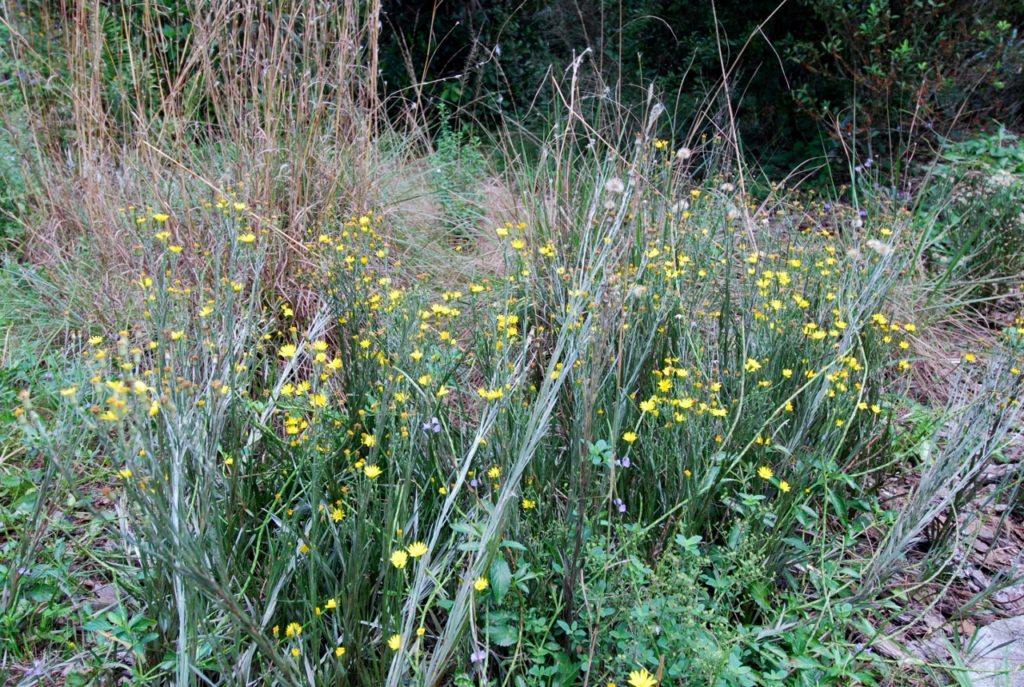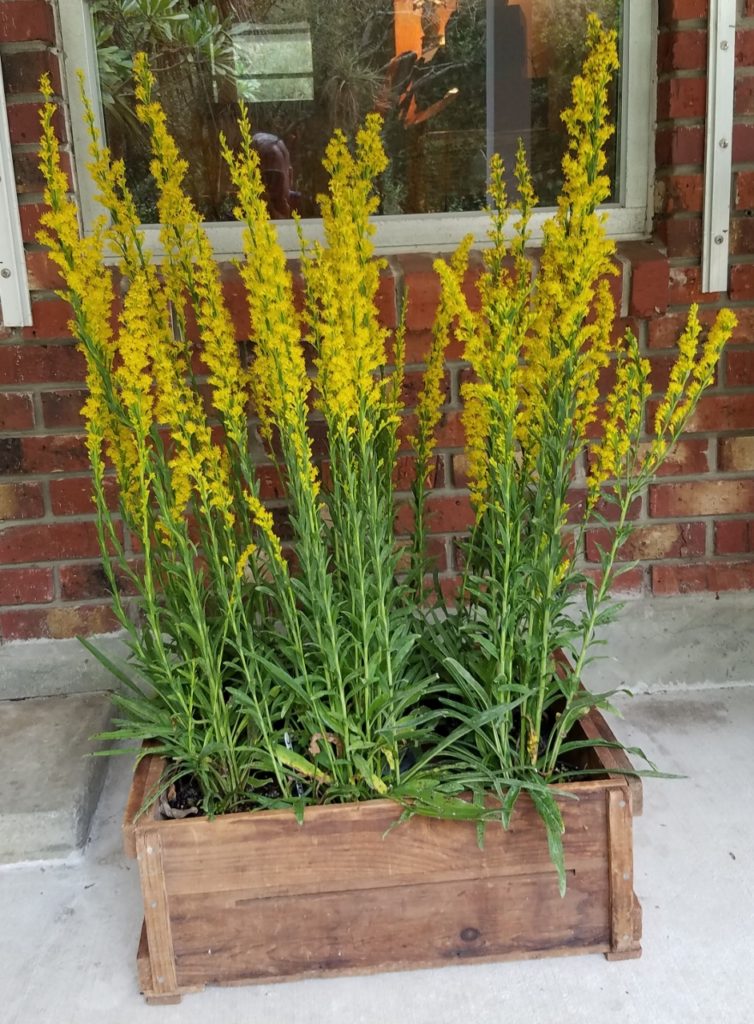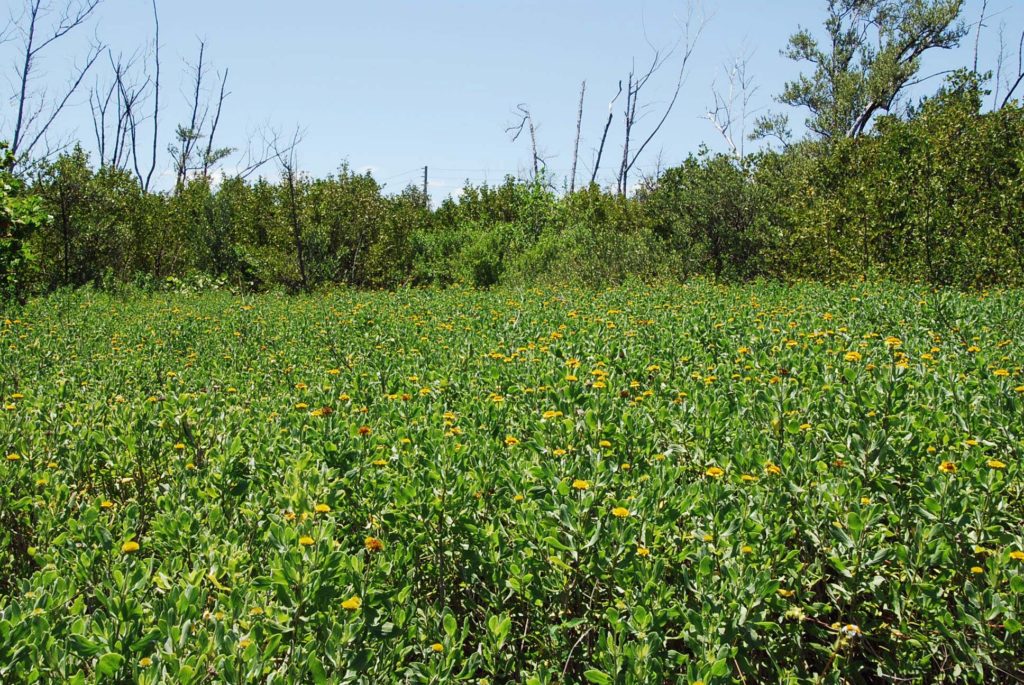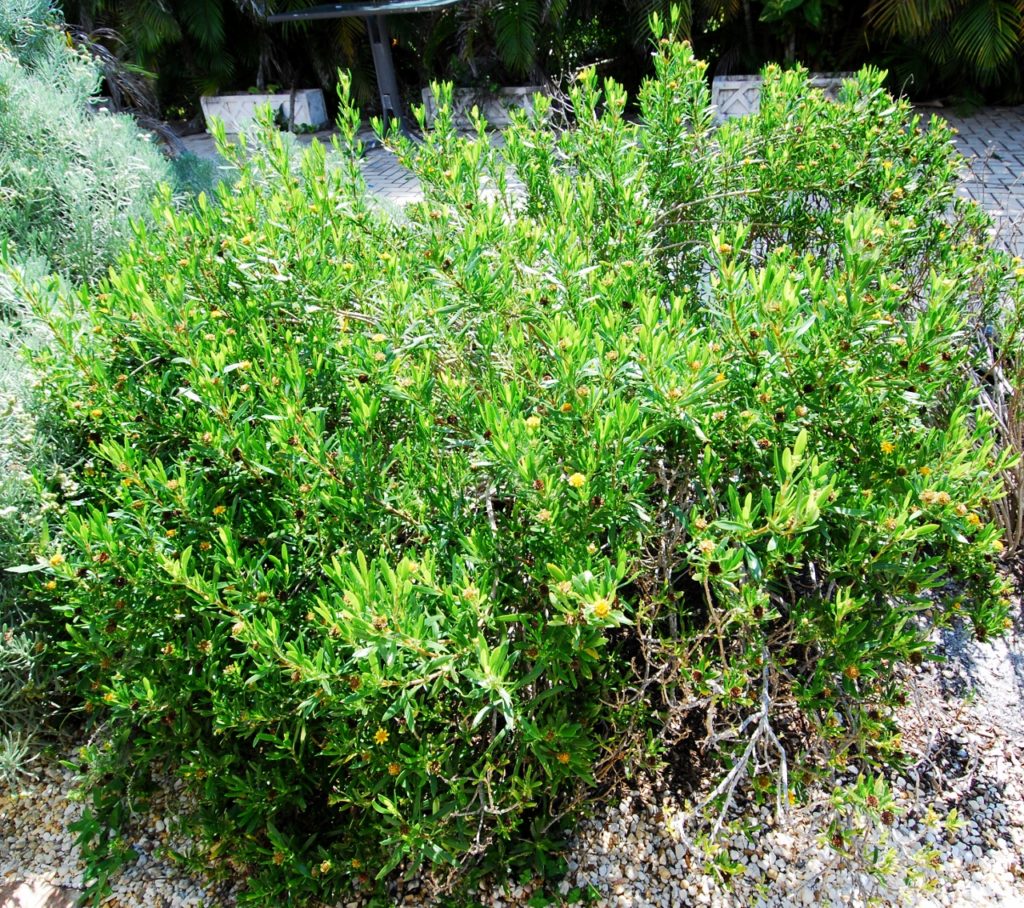Starry Rosinweed
Silphium asteriscus var. angustatum
Starry Rosinweed or Silphium is native to the dry sandhills of western Central Florida and the Panhandle. Click here. This is drought tolerant once established and is long lived with five years or more expected with a little care. Water during persistent drought and fertilize if needed.
All butterfly gardens must have this, top of the list, nectar producing plant. The leaves become old and the plant takes on a tired look for a couple of cold winter months, yet grows back quickly and flowers from spring thru fall.
Siphium mixes well with Silk Grass, Purple Coneflower, Salvia, Horsemint, Blue Curls, Blazingstar, Mimosa, Deertongue, Pineland Dropseed, Love Grass, Pineland Petunia, Melanthera, Scrub Goldenrod and Beach Verbena.
Since the leaves lie fairly flat and are tired looking during the winter, plant this wildflower in the back where the two foot tall flower stalks can rise above the other plants.
Spotted Beebalm
Monarda punctata
Spotted Beebalm or Horsemint is found throughout most of Florida, especially along the coast, and the eastern half of the U.S. and Canada. Salt air, but not much salt water, is tolerated behind the coastal dunes.
Some butterflies will visit the flowers, yet this is a great plant for bees and other pollinators. The purple to pink bracts have white with purple spotted flowers above them. Flowering is from June thru early fall.
Spotted Beebalm needs full sun to partial shade and dry soil. Other subspecies and varieties occur throughout the U.S. in prairies and other open dry ground. The height is usually below two feet with a similar spread. In very favorable conditions it may reach three feet in height.
Chew a leaf for a natural burst of spear minty flavor. It reminds me of Altoid mints without any sugar. Dried or fresh leaves make a great tea for colds or refreshment. Sometimes I use them in cooking.
You will definitely start seeing this plant growing along A1A near Sebastian Inlet State Park and north, yet start looking along the coast in Martin County.
Definitely include this plant when landscaping for pollinators. Seedlings will come up each year in a different location, yet they are not numerous and are easily controlled. Cutting the plant to six inches after it flowers may give you another blooming period, yet few seeds to come up later.
This plant will hold its own with other pushy wildflowers. Mix with Dune Sunflower, Gaillardia, Red Salvia, Blue Curls, Seaside Goldenrod, Beach Verbena, Coontie, Cactus, Spiderlily and other coastal plants.
For more info Click here, and here.
Spiderwort
Tradescantia ohiensis
Ohio Spiderwort can be found from Maine to Florida and west to Texas. It is the most widely distributed spiderwort and the most likely to be found in the eastern U.S.
It forms clumps of blue green leaves that stay below two feet tall. The flower stalks rise up to about two feet and produce clusters of blue flowers. Pink and purple are often produced and very rarely white.
This is a tough plant that takes moist to sugar sand soils. It also grows on the back side of the dune starting around Cocoa Beach. Look for it also where 528 goes west of Cape Canaveral over the marshes and on the old white sand scrub along U.S.1.
Spiderwort will flower from February to late June. You may want to cut the old seed heads off and place where you want seedlings to come up or just lay them near the original plant to extend it.
In fertile moist soil the plant will produce a nice groundcover of leaves all year and may flower a bit more. In dry soil, the plant may disappear for a couple of months, yet usually returns from the root mass. Watch for tiny succulent seedlings too.
Once established, Ohio Spiderwort is hard to remove. Roundup does little damage leaving you to hand pulling. Do not mow the old seed stalks or you will have this plant all over the place.
Bumble and other bees do the pollination, so don’t expect butterflies on this plant. We have seen painted buntings eat the seeds.
The leaves have slimy sap yet cook up into a nice stir fry. The pink, white and blue flowers can be used for a Fourth of July salad. Almost all green plants will make your dog throw up, but this one is not poisonous.
It is in the Commelinaceae family. Some of the exotic members of this family are poisonous, but the red leaves of Oyster Plant and Wandering Episcopalian plant are obvious compared to the green, grassy leaves of the Spiderwort.
Use Spiderwort where you need a low clumping plant. Since it has its ups and downs, I mix it with other plants and don’t use it as a solid border in the front.
In a moist site, Prairie Iris, Black Eyed Susan, Tickseed and Spiderwort go well together. It grows naturally with Seaside Goldernrod, Red Salvia, Beach Verbena, Dune Sunflower, Spiderlily, Coontie, Sea Oats, Railroad Vine, Southern Beebalm, Beach Croton, Gaillardia and Blue Curls.
Full sun is best, yet this can be grown under the shade of Live Oak and other trees that allow some light to get thru. When driving along Merritt Island, look for the blue flowers under oak trees in roadside yards.
Spiderwort is one of the spring wildflowers that will liven your yard. The flowers only last until 1 pm but are worth the early retirement. You can even add them to your vegetable garden for a native green. This is a must for people wanting to attract bees.
For info on the Ohio Spiderwort click here, and info on the related Virginia Spiderwort, Click here. And here’s a great article about its past and edibility, Click here.
Mangrove Spiderlily
Hymenocallis latifolia
Mangrove Spider Lily is one of the most drought and salt tolerant groundcovers available. It grows from Volusia County south through the keys among the coastal dunes and raised areas within mangrove swamps. It can tolerate some salt spray and flooding as well as full sun to moderate shade.
The strap shaped leaves are three inches wide and reach almost three feet tall before bending over. Clusters of numerous fragrant white flowers are produced at the top of a three or more foot fleshy stalk in mid summer. There is a membrane connecting the filaments producing the appearance of an umbrella pushed upwards by high winds.
The seeds are like green bulbs and each produces one plant. Several are found at the tip of the flower stalk in late summer. These seedlings take one to two years to produce a sizable plant. It may be better to just divide a clump of bulbs to get more plants.
One bulb will become a cluster of three or more in one year and a mass of many by the third or fourth year. Each mass can be three feet across. Plant two to three feet apart for a continuous bed of leaves and flowers.
Since this is a member of the Amaryllis family, do not eat it or get sap on your skin. Moths visit the fragrant flowers at night and lubber grasshoppers, which are red and yellow, eat the leaves.
The poisonous is stored in its body making anything that tries to eat it sick. Remember that red, yellow and black are warning colors; think black widow spider, coral snake, atala hairstreak butterfly and larva.
Try using Mangrove Spider Lily in the driest parts of your planting. If you are doing a beach planting or creating a beach or Keys theme, individual or groups of these plants give a nice texture change and lovely flowers. Keep in mind that the leaves melt down in winter and may need to be removed until new, attractive growth takes their place.
For a natural look; mix with Beach Cocoplum, Sea Lavender, Bay Cedar, Sea Oats, Beach Verbena, Dune Sunflower, Beach Elder, Coontie, Seaside Joyweed, Gaillardia, Blue Curles, Southern Beebalm and other coastal plants.
Click for more info.
Florida Spiderlily
Hymenocallis tridentata
Florida Spiderlily is found in marshlands and swamps from Vero Beach south. The lower picture is of a marshy area 500 feet or so west of the visitors center at Arthur R. Marshal Loxahatchee Preserve near Boynton Beach, in Palm Beach County, Florida. It is not salt tolerant.
The leaf blades are under 12 inches long and there are up to three, three inch wide flowers per head. This can be compared to the Alligator lily which is found in similar habitats, but has only one flower, click here, or the Mangrove spiderlily, which is found on beaches and other coastal areas, click here.
I have used Florida Spiderlily in moist and very dry areas with great success. It is wonderful in masses and makes a nice border replacing Liriope. Single plants are nice mixed into a flower garden.
The white flowers are fragrant at dusk when they attract various moths to pollinate them. Each bulb divides until the plant becomes around 18 inches across. Seeds are rarely produced.
Like all members of the Amaryllis family, all plant parts are poisonous. This may be why lubber grasshoppers eat the leaves: so when something eats them, the experience is not forgotten…if survived.
Although this is a great wildflower mixed with anything that won’t overtake it, I feel that one of the best uses is to fill a water retention area that fills briefly. Here it can be mixed with Duck Potato, Prairie Iris, American Crinum Lily, Yellow Canna, Water Hyssop, Pond Cypress and other wetland species.
The lower picture above will help you imagine how to use this enchanting plant.
click for more info.
Skyblue Clustervine
Jaquemontia pentanthos
This is a long lived twining herbaceous vine that will cover a fence and has 3/4 inch blue flowers for most of the year. These peak in spring and late summer. It is naturally found along the edge of hammocks in the Upper Keys, Everglades Rocklands near Long Pine Key and some places near the Key Deer Refuge. Full sun is best.
Skyblue Clustervine is listed as endangered and does well in counties outside it’s natural range. It will tolerate moderate salt winds and drought along with almost any moderately fertile soil. The natural soil for this plant is composed of coral rock and limestone. It will not tolerate salt or fresh water flooding or a freeze.
You may want to cut it back to three to six feet during the winter. This will force more attractive new growth and remove old leaves and stems.
Several butterflies will nectar on the flowers and seed eating birds will visit it. If you are growing Whiteflower Passionflower on a fence to provide larval food for Julia butterflies, Skyblue makes a nice companion that adds lots of color. Coral Honeysuckle, Man In The Ground, Corky Passionflower, smaller leaved pipevines and other less aggressive vines will also mix well.
Click for more info.
Narrowleaf Silkgrass
Pityopsis graminifolia
Several species of silkgrass are native to dry pinelands, scrub and moist pinelands in Florida and extend up the East Coast to Delaware and west to Texas. Neither drought or cold will harm this plant. The scrub inhabiting, Pityopsis graminifolia var. latifolia, top picture, tends to stay as a clump.
The moist pineland Pityopsis graminifolia var. tracyi, lower picture, suckers and makes moderate sized dense colonies. Both are common in South Florida and are most likely the ones you will find in the wild.
The silvery 12 inch long leaves are one half inch wide and upright. By August small, yellow, butterfly attracting flowers form which ripen into heads of slender seeds. The leaves are eaten by gopher tortoises which are found in these plants’ natural environment.
Both are very drought tolerant plants that last for years. The only care either needs is to cut off the old leaves and flower heads at the end of November. Simply mow or cut with manual hedge trimmers. Few seedlings will come up on their own.
Garden soil can be moist to very dry. Silk grass is naturally mixed with Blazing Star, Partridge Pea, Gopher Apple, Rock Rose, Wire Grass, Cacti, Saw Palmetto and
Scrub Oaks under the canopy of scattered Slash or Sand Pines.
For info about the various species and varieties Click here. See page 13 for a description of Pityopsis graminifolia var. latifolia that is common in scrub habitat of South Florida, and see page 16 for a description of the colony forming Pityopsis graminifolia var. tracyi that is most common in moist pinelands of South Florida.
A mass of tracyi silk grass is impressive if you are following a “silver” theme. I like it as an understory to the various Thatch Palms, Buccaneer Palm, Necklace Pod, Bahama Strongbark, Cinnamon Bark and other plants with a couple of feet of clean trunk.
This makes a great edge to replace Liriope Grass and mixes well with most plants in a wildflower garden. Just give tracyi room to form its lovely colony. The latifolia variety makes nice accents that jump out of the garden. Plant in groups or as singles.
For more info click here,
Seaside Goldenrod
Solidago sempervirens
There are two varieties of Seaside Goldenrod. The first, Solidago sempervirens L. var. mexicana, is found along the east coast from New York to Florida. This is the smaller of the two and occurs inland as well as near the beach. The second is Solidago sempervirens L. var. sempervirens. This is taller than the former and occurs on the East Coast west to Indiana from Canada to Virginia.
I have found the taller variety on the coast of Brevard County which was well south of Virginia. The flower stalks can reach six to eight feet depending on the variety and the leaves of both make a compact clump. Tea is made of the leaves.
Both bloom in November and the stalks can be kept shorter and branched by cutting them to the ground in August or September. Several shorter stalks, around three feet tall, will grow back and bloom by November. Any dry soil will do. This mixes well with other seaside plants, especially Spiderwort.
The pictured variety, “mexicana” makes a nice low clump that may be three or more feet in diameter. It looks similar to Solidago stricta but lacks the surface stolons and has larger leaves on the flower stalk. Stricta is smaller and forms mats in wetlands. Click for photos of stricta.
Both blend well with Pine Trees, Spartina Grass, Seaside Mallow, Spiderwort, Ironweed, Beach Verbena, Spiderlily, Red Salvia and many other clumping wildflowers. The low Sunshine Mimosa, Fog Fruit, Lyre Leaf Sage, Seaside Joyweed and other ground hugging plants will provide a nice base to show off this plant.
The flower stalks make nice cut flowers for fall arrangements. The pollen is heavy and sticky so can only be spread by insects and other creatures and not the wind as previously thought. Think of “Sneezy,” the dwarf in Snow White, sneezing over goldenrod…not true.
Ragweed, which has green flowers, blooms at the same time and has wind spread pollen. You don’t see it so you assume that the visible goldenrod is causing your hayfever; a priori reasoning.
Butterflies, beetles, flies, and other pollinators along with predatory insects eat the pollen and drink the nectar. For bio control of pests, planting goldenrod should be part of your approach.
Personally, I think the combination of goldenrods and New England Aster is what makes vacant fields so beautiful in the fall up north. Down here, Spiderworts provide the blue.
Click for more info, and here. Here’s more info on goldenrods than you every thought you’d need, Click here.
Silver Sea-Oxeye-Daisy
Borrichia frutescens
Silver Sea-Oxeye-Daisy Is commonly found in salty environments from Maryland through the Florida Keys and west to Texas. It grows along the mangrove or saltmarsh fringe and on dune backs containing some organic matter.
Another similar plant, the Green Sea-Oxeye-Daisy is found mainly in South Florida. Click here. This plant is bushy and doesn’t sucker much, while the Silver Sea Oxeye suckers everywhere, even ten feet away.
This quality makes the silver form suited to boxed in areas where you want a full planting. I have used it in planters, along the intracoastal waterway and other sites with cement surrounding them.
This is also an edible plant, Click for more info. It is a bit bitter, yet it may be fun to try a small serving to see how you like it.
The silver leaves, two to three foot height, yellow flowers and ability to fill in a dry, sunny spot make this a great groundcover. Butterflies visit the flowers and birds, including painted buntings, eat the tiny seeds. The flower heads are a bit spiny, so don’t plant where you may brush up against it.
Various insects eat the seeds, foliage and cause galls within the stems. This makes it a source of insects for many bird species. The damage is usually not noticeable and should be tolerated.
For a mass planting in a low site, especially if it is saline, this is a great choice. Just give it its own space.
Click for more info, and here.
Green Sea-Oxeye-Daisy
Borrichia arborescens
Green Sea-Oxeye-Daisy is native from Biscayne National Park down through the Florida Keys. It is naturally found near salt marshes where it grows from commonly three, yet up to five feet tall.
Both the green and silver Sea-Oxeye-Daisy have leaves that can be eaten raw, yet are not tasty. Click for more info. Still, it is nice to know they are not poisonous if eaten in moderation.
Butterflies, bees and other pollinators visit the flowers. Donna and I have observed painted buntings eating the seeds of the silver species up in Jacksonville during the summer.
Green Sea-Oxeye-Daisy grows in a large clump that doesn’t run off the way the silver species does. It fills with yellow flowers throughout the spring and summer and has succulent leaves. This makes a great background plant for a sunny butterfly garden.
Plant with Scorpiontail, Silver Sea-Oxeye-Daisy, Sea Lavender, Chapman’s Cassia and Chapman’s Goldenrod, Key Lily, Coontie, Salvia, Giant Leather fern, Seaside Goldenrod and Beach Elder. Many lower species of wildflowers can be planted below. Sunshine Mimosa, Beach Verbena, Dune Sunflower, Twinflower, Pineland Petunia, Seaside Joyweed and Spiderwort are just a few.
click for more info.
